
The Basics:
- For ages 10 and up (publisher suggests 8+)
- For 2 to 6 players
- Approximately 90 minutes to complete
Geek Skills:
- Active Listening & Communication
- Counting & Math
- Logical & Critical Decision Making
- Reading
- Risk vs. Reward
- Hand/Resource Management
Learning Curve:
- Child – Moderate
- Adult – Easy
Theme & Narrative:
- Scrooge is a [CENSORED]!
Endorsements:
- Gamer Geek rejected!
- Parent Geek mixed!
- Child Geek mixed!
Overview
Author, thought leader, and global champion for equal human rights, Bryant H. McGill, said “The world is not fair, and often fools, cowards, liars and the selfish hide in high places.” Scrooge is such an individual, high is station and influential, but for all the wrong reasons, making him a bane to humanity instead of a blessing. But on this Christmas Day, Scrooge is about to have a reckoning and you get to be a part of it.
Scrooge: The Board Game, designed and self-published by Simon Gerring, Jason Gerring, and Peter Gerring, is comprised of one game board, six Playing pieces, seven Character cards, 39 Ghost cards, 12 Hero and Villain cards, 36 Scrooge’s Money-Box cards, 22 Pure Nightmare cards, 8 Turning Point cards, 36 Scrooge’s Bag of Tricks cards, one standard six-sided die, one Marley die (a customized six-sided die), a various assortment of paper money meant to represent gold, and two reference cards. The cards are as thick and as durable as your standard playing card and the game board is made of solid cardboard. The money/gold is thin paper and prone to creasing and ripping.
Game Set Up
To set up the game, first separate the cards by their five themed categories. Shuffle each and place face-down on their designated spaces on the game board. These are the five draw decks for the duration of the game.
Second, have each player select a Character card and its corresponding character piece. Players should place their Character piece on the “start” space on the game board. Place any unused Character cards and matching charter pieces back in the game box.
Third, separate the Turning Point card from the Nightmare deck. Each player selects one Turing Point card at random. Players should keep the card they selected a secret at this time. Place any remaining Turning Point cards back into the Nightmare deck and shuffle.
Fourth, draw 5 Hero & Villain cards at random, placing them face-down in a row by street 56 (found on the game board). Any remaining Hero & Villain cards are returned to the game box. Make sure the players do not see the cards being returned to the game box!
Fifth, give each player 1000 Gold in the values of one $250, four $100, five $50, and four $25. All remaining Gold is placed in stacks. These stacks represent Scrooge’s bank.
Sixth, place $500 worth of Gold into Scrooge’s Counting House (found on the game board).
That’s it for game set up. Elect one player to manage Scrooge’s bank (we suggest the oldest and most math-proficient player). Determine who will go first and begin.
Redemption and Commerce
Scrooge is played turns with no set number of turns per game. If a player ever runs out of gold during their turn or the result of an action taken against them by an opponent, they are out of the game. A player’s turn is summarized here.
Step One: Decide Movement
On their turn, the first thing a player must do is determine how their Character piece will move, deciding on the direction on the game board, and then announce it to the group. Character pieces can move forwards or backwards. If the player fails to announce the direction their piece will move, their opponents may call them on it. If they do, the player must move their piece forward by default.
There are three different methods to determine movement:
- Roll the dice. Roll either one or two dice. The combined number rolled is the number of spaces the Character pieces moves in the direction indicated by the player. If a player rolls a combined roll of minus two or minus one, they must move in the opposite direction they announced that many number of spaces. If the combined rolled value is a zero, the player’s piece does not move and the space action is not resolved.
- Pay to move. Move up to six streets (spaces) by paying to Scrooge’s bank $250 Gold for every street moved. Players do not collect Gold for moving backwards if they pay to move.
- Use a Ghost Card that specifically allows you to replace your turn.
Step Two: Resolve Space
After the player moves, the space where their Character piece stops is the space that the player must now resolve. Follow the action noted on the space and only one space is resolved on the player’s turn at maximum. This is important as a player’s piece may be bounced from one space to another during their turn or during an opponent’s turn.
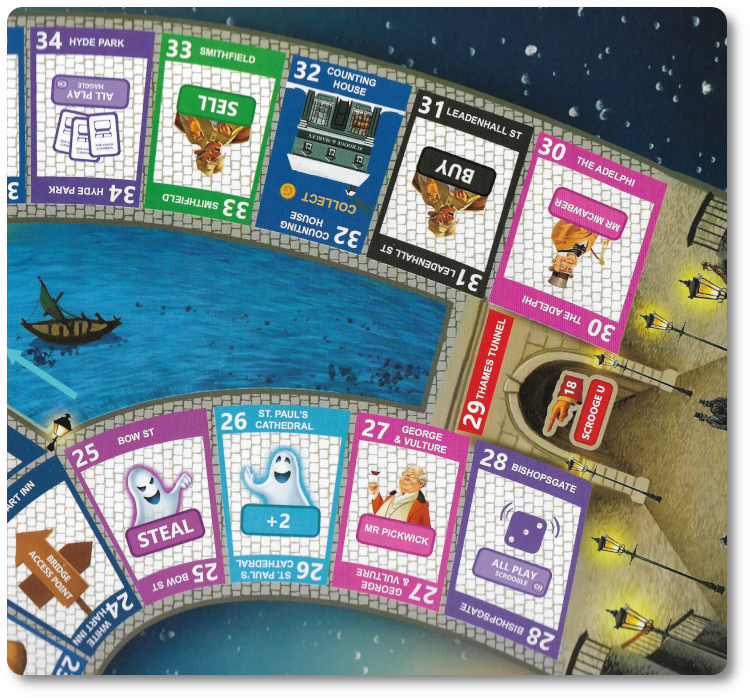
This ends the player’s turn unless a card is involved. The next player in turn order sequence now goes.
Playing Cards
While the above steps to complete a player’s action are always available, playing cards is always a possibility. Some cards are given to the player when the space action they land on is resolved. Some cards are purchased or are awarded, allowing the player to keep them for later use. Each of the card types are summarized here.
Scrooge’s Bag of Tricks Cards
These cards are similar to a real life speed bump in the road. They are designed to slow a player down and cause them grief by moving their player piece around the board and reducing the players’ collected gold. If a player’s action is to collect Scrooge’s Bag of Tricks cards, they draw the number noted from the top of the draw deck. However, instead of keeping these cards, they hand them to the player currently in the lead who must then resolve them on their next turn. If the player is in the lead, they draw the cards and immediately resolve them one at a time and in the order in which they were drawn.
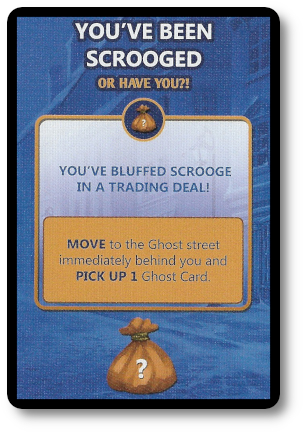
Scrooge’s Money-Box Cards
These cards may allow the player to collect gold or lose gold, depending on what the card drawn states. These cards are also used during the endgame.
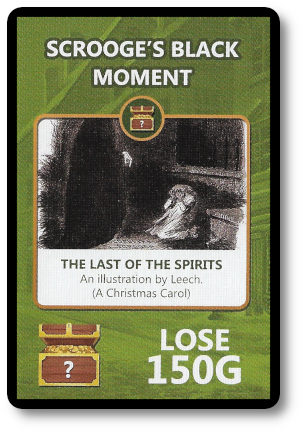
Ghost Cards
These cards are similar to Scrooge’s Bag of Tricks, but work for the player, not against them. They are collected by the player when they land on a space that provides them and can be played at anytime during the game or used to replace the player’s turn (the Ghost card states which of these two options are available). No more than five Ghost cards can be held by the player. Some Ghost cards allow the player to take actions against their opponents. If their targeted opponent has the correct Ghost card, they may block such an action by playing the appropriate card.
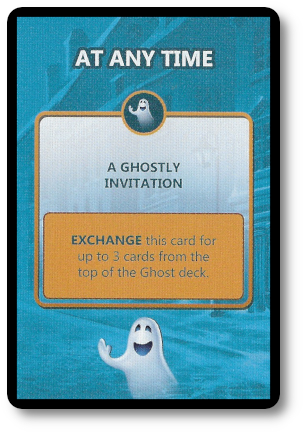
Nightmare Cards and Turning Point Cards
There are two types of Nightmare cards. These are Pure Nightmares and Turning Points. These cards represent the troubled mind of Scrooge as he is haunted by his past and the possible turning point in Scrooge’s life where the stops being a selfish money-grabber to selfless philanthropist. Players will collect gold if they sell these cards, but they can only sell them at certain spaces on the game board. If the player hopes to confront Scrooge, they must not have any of these cards in their hand, making them something of a liability.
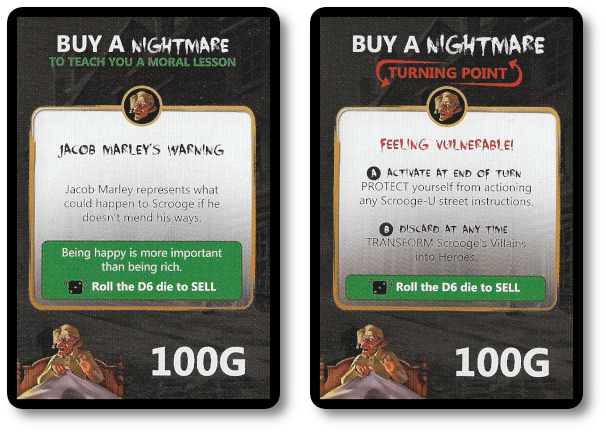
Hero and Villain Cards
These cards represent some of the people in Scrooge’s life that will help you confront him (including Scrooge himself). Some of these cards (the Heroes) will be on the player’s side, helping the player to complete the game. The others, not so much. These cards (the Villains) are afraid of Scrooge or are just as nasty as him, weakening the player’s ability to confront the stingiest man in town.
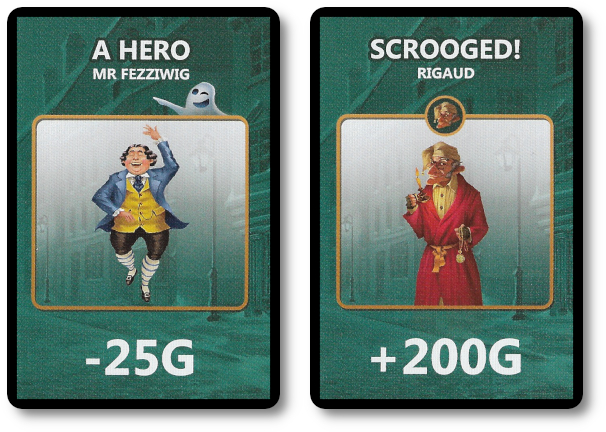
A Light in the Darkness
If a player lands on “Scrooge’s Moment of Truth” space on the game board, they may confront Scrooge in hopes of changing the old man’s heart and win the game. However, to do so, the player must not be holding any Pure Nightmare cards and have at least 500 gold (which is paid to Scrooge if the player fails to change the old man’s mind). If the player meets these conditions, three Money cards are drawn for the player and three are drawn for Scrooge. In addition, one Heroes and Villains card is also taken and placed with the cards given to Scrooge.
Thematically speaking, the player is now confronting Scrooge, face-to-face. Mechanically, this is done in the game by the player and Scrooge (who is under the control of a player’s opponent) taking turns showing their hand of Money cards. The Hero and Villain cards will either add or subtract to the Scrooge’s total. In addition, each of the player’s opponents have this one opportunity to play cards that might hurt or harm the player’s chances of winning.
If the player’s hand size value noted by the Money cards is higher than Scrooge’s hand, the player wins! If the player’s hand size value is lower than or equal to Scrooge’s hand, the player is kicked out of Scrooge’s office and sent back to the space they originated from before moving. The player also loses their 500 gold and the drawn Hero and Villain card used during the confrontation is placed in the game box (making it unavailable for the duration of the game).
Game Variant
The basic game summarized above has a lot of little rules that can make the game difficult to teach and for casual or young players to enjoy. This game variant reduces the number of rules in the game, the number of cards used, increases the total number of gold the player starts with, and makes confronting Scrooge easier.
To learn more about Scrooge: The Board Game, visit the game’s website.
Final Word
 The Child Geeks had difficulty with this game and became frustrated with the continuous setbacks and obstacles the game randomly threw at them. According to one Child Geek, “I think this game is way to hard at times and other times way to easy.” What the Child Geeks really didn’t like is that they could be kicked from the game from losing their gold. As one Child Geek put it, “I had to lose the game because I landed on a space. That made me mad.” We began to teach and play the game using the game variant that reduces many of the game’s rules and greatly reduces the chances of the player being removed from the game. This helped, but it also made the game feel more like Candy Land, which is not a game any of our Child Geeks enjoy. The end result was a game that the Child Geeks either loved or hated. In regards to the vote, it was more or less a 50/50 split.
The Child Geeks had difficulty with this game and became frustrated with the continuous setbacks and obstacles the game randomly threw at them. According to one Child Geek, “I think this game is way to hard at times and other times way to easy.” What the Child Geeks really didn’t like is that they could be kicked from the game from losing their gold. As one Child Geek put it, “I had to lose the game because I landed on a space. That made me mad.” We began to teach and play the game using the game variant that reduces many of the game’s rules and greatly reduces the chances of the player being removed from the game. This helped, but it also made the game feel more like Candy Land, which is not a game any of our Child Geeks enjoy. The end result was a game that the Child Geeks either loved or hated. In regards to the vote, it was more or less a 50/50 split.
 The Parent Geeks, like the Child Geeks, either loved or hated the game. This is important to note as the game polarized a player’s opinion. We never once heard from a player that said the game was either “just OK”. It was always “great!” or “awful”. According to one Parent Geek who enjoyed the game, “I liked it. Each roll of the die presents the player with a new challenge they must encounter and hopefully resolve to their benefit. But watch out! The streets of old London are dangerous and the ugly influence of Scrooge is everywhere!” In contrast, a Parent Geek who did not care for the game said, “I roll and I move and I cross my fingers that I advance in the game. But all my planning means little when even the direction I want to move and the actions I want to take are decided by the roll of a die. I didn’t care for the game because I felt like I couldn’t make any meaningful decisions, just meaningful acceptance of my fate.” The Parent Geeks voted, resulting in this crowd giving Scrooge: The Board Game a mixed endorsement.
The Parent Geeks, like the Child Geeks, either loved or hated the game. This is important to note as the game polarized a player’s opinion. We never once heard from a player that said the game was either “just OK”. It was always “great!” or “awful”. According to one Parent Geek who enjoyed the game, “I liked it. Each roll of the die presents the player with a new challenge they must encounter and hopefully resolve to their benefit. But watch out! The streets of old London are dangerous and the ugly influence of Scrooge is everywhere!” In contrast, a Parent Geek who did not care for the game said, “I roll and I move and I cross my fingers that I advance in the game. But all my planning means little when even the direction I want to move and the actions I want to take are decided by the roll of a die. I didn’t care for the game because I felt like I couldn’t make any meaningful decisions, just meaningful acceptance of my fate.” The Parent Geeks voted, resulting in this crowd giving Scrooge: The Board Game a mixed endorsement.
 Oh, goodness, how the Gamer Geeks despised this game. According to one Gamer Geek who provided feedback that was mostly riddled with expletives, “Total [censored]. This game is poorly designed and is little more than a roll-and-move nightmare. I never cared who won or lost and had very little control over my actions in the game.” Another Gamer Geek said, “This is not a game any self-respecting Gamer Geek would want to approach, let alone play. Your decisions are made by the game with the player’s only role to keep a chair warm and help move pieces around the board.” Needless to say, the Gamer Geeks spent little time debating their decision about the game and promptly voted to reject it.
Oh, goodness, how the Gamer Geeks despised this game. According to one Gamer Geek who provided feedback that was mostly riddled with expletives, “Total [censored]. This game is poorly designed and is little more than a roll-and-move nightmare. I never cared who won or lost and had very little control over my actions in the game.” Another Gamer Geek said, “This is not a game any self-respecting Gamer Geek would want to approach, let alone play. Your decisions are made by the game with the player’s only role to keep a chair warm and help move pieces around the board.” Needless to say, the Gamer Geeks spent little time debating their decision about the game and promptly voted to reject it.
 Like some of the Child Geeks and Parent Geeks and all of the Gamer Geeks, I didn’t care for this game. It felt too heavy with its rules and too fiddly with its game play. Lots of “this happens but only if this happens” kind of moments. This also made the game difficult to teach, with many of our game play sessions being taught as the game progressed (makes no sense to describe how the 20 or so different space actions are resolved before you hit them). The random outcomes also made the game challenging to tolerate, as the players are continually bumped around the game board and held hostage by a simple die roll value that determines their progress. As a result, the game felt very reactionary instead of actionable. No real thought went into my turns. The goal was obvious and the only thing I could do is just keep moving towards it, one awkward turn at a time. The final result is that this game felt like a chore that I just needed to complete versus a fun experience I didn’t want to end.
Like some of the Child Geeks and Parent Geeks and all of the Gamer Geeks, I didn’t care for this game. It felt too heavy with its rules and too fiddly with its game play. Lots of “this happens but only if this happens” kind of moments. This also made the game difficult to teach, with many of our game play sessions being taught as the game progressed (makes no sense to describe how the 20 or so different space actions are resolved before you hit them). The random outcomes also made the game challenging to tolerate, as the players are continually bumped around the game board and held hostage by a simple die roll value that determines their progress. As a result, the game felt very reactionary instead of actionable. No real thought went into my turns. The goal was obvious and the only thing I could do is just keep moving towards it, one awkward turn at a time. The final result is that this game felt like a chore that I just needed to complete versus a fun experience I didn’t want to end.
If we consider that this is a game designed to be played around the Holiday season, one can excuse its foibles, counting them as “just part of the game”. I could certainly tolerate this game once a year without issue. Where the game quickly loses its luster is when you have to play the game multiple times. You quickly see the game’s weaknesses, everything from its flimsy paper money to the continues random outcomes.
On the bright side, the game design and game play lets anyone, regardless of skill and background sit down and play it. The game is suggested for players are young as eight years old, but I suggest your youngest players be around ten years old because of the continues set backs the game throws on the player. We found that younger players lost interest or became so fed up with the continues changes in the game they had no control over that they wanted to stop playing. That’s not a great sign when the players at the gaming table are eagerly looking to leave. In addition, the learning curve for the game is a bit harder for the Child Geeks. This is because of the many little rules that the game includes using the cards.
I personally cannot recommend this game, but I understand its appeal. To many, a festive game board to play with friends and family during the Holiday season is of great value. The game’s theme is one of redemption and greed, of personal perseverance and the shortcomings of selfish behavior. In theory. Most of the time, you’ll just feel pushed and pulled in directions that are not of your design. Bah, humbug, I say, to Scrooge: The Board Game.
This game was given to Father Geek as a review copy. Father Geek was not paid, bribed, wined, dined, or threatened in vain hopes of influencing this review. Such is the statuesque and legendary integrity of Father Geek.



